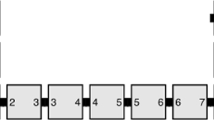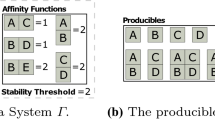Abstract
Tile-based self-assembly systems are capable of universal computation and algorithmically directed growth. Systems capable of such behaviors typically make use of “glue cooperation” in which the glues on at least 2 sides of a tile must match and bind to those exposed on the perimeter of an assembly for that tile to attach. However, several models have been developed which utilize “weak cooperation”, where only a single glue needs to bind but other preventative forces (such as geometric, or steric, hindrance) provide additional selection for which tiles may attach, and where this allows for algorithmic behavior. In this paper we first work in a model where tiles are allowed to have geometric bumps and dents on their edges. We show how such “geometric” tiles can simulate systems of square tiles with complex glue functions (using asymptotically optimal sizes of bumps and dents). We then show that at scale factor 1 it is impossible for geometric tiles to simulate the behavior of systems which can include duples (i.e. tiles either twice as long or twice as tall as square tiles), and also that with only weak cooperation via geometric hindrance, no system in any model can simulate even a class of tightly constrained, deterministic cooperative systems. This helps to further define the limits of the powers of systems relying on geometric hindrance instead of glue cooperation.A shortened version of this paper appeared in the proceedings of the 18th International Conference on Unconventional Computation and Natural Computation (UCNC 2019).

















Similar content being viewed by others
Explore related subjects
Discover the latest articles, news and stories from top researchers in related subjects.Notes
Note that rectilinear systems can also be simulated, and they have similar properties except that they may have multiple frontier locations available.
Note that with negative glues, more complex dynamics, which include the breaking apart of assemblies, are possibleLuchsinger et al. (2018).
Note that \(R^*\) is a total function since every assembly of S represents some assembly of T; the functions R and \(\alpha \) are partial to allow undefined points to represent empty space.
With an exception which is noted in Sect. 5.
We’ll refer directly to the arXiv version here https://arxiv.org/pdf/1304.1679.pdf for convenience
References
Cook M, Fu Y, Schweller RT (2011) Temperature 1 self-assembly: Deterministic assembly in 3D and probabilistic assembly in 2D. In: SODA 2011: Proceedings of the 22nd Annual ACM-SIAM Symposium on Discrete Algorithms. SIAM
Demaine ED, Demaine ML, Fekete SP, Patitz MJ, Schweller RT, Winslow A, Woods D (2014) One tile to rule them all: Simulating any tile assembly system with a single universal tile. In: Proceedings of the 41st International Colloquium on Automata, Languages, and Programming (ICALP 2014), IT University of Copenhagen, Denmark, July 8-11, 2014,LNCS, vol. 8572, pp. 368–379
Doty D, Kari L, Masson B (2013) Negative interactions in irreversible self-assembly. Algorithmica 66(1):153–172
Doty D, Patitz MJ, Summers SM (2011) Limitations of self-assembly at temperature 1. Theor Comput Sci 412:145–158
Fekete SP, Hendricks J, Patitz MJ, Rogers TA, Schweller RT (2015) Universal computation with arbitrary polyomino tiles in non-cooperative self-assembly. In: Proceedings of the Twenty-Sixth Annual ACM-SIAM Symposium on Discrete Algorithms (SODA 2015), San Diego, CA, USA January 4-6, 2015, pp. 148–167 https://doi.org/10.1137/1.9781611973730.12. http://epubs.siam.org/doi/abs/10.1137/1.9781611973730.12
Fu B, Patitz MJ, Schweller RT, Sheline R (2012) Self-assembly with geometric tiles. In: Proceedings of the 39th International Colloquium on Automata, Languages and Programming, ICALP, pp. 714–725
Gilbert O, Hendricks J, Patitz MJ, Rogers TA (2016) Computing in continuous space with self-assembling polygonal tiles. In: Proceedings of the Twenty-Seventh Annual ACM-SIAM Symposium on Discrete Algorithms (SODA 2016), Arlington, VA, USA January 10-12, 2016, pp. 937–956
Hader D, Patitz MJ (2019) Geometric tiles and powers and limitations of geometric hindrance in self-assembly. In: Proceedings of the 18th Annual Conference on Unconventional Computation and Natural Computation (UCNC 2019), Tokyo, Japan June 3–7, 2019, pp. 191–204
Hendricks J, Patitz MJ, Rogers TA (2016) Doubles and negatives are positive (in self-assembly). Nat Comput 15(1):69–85. https://doi.org/10.1007/s11047-015-9513-6
Hendricks J, Patitz MJ, Rogers TA, Summers SM (2015) The power of duples (in self-assembly): It’s not so hip to be square. Theor Comput Sci. https://doi.org/10.1016/j.tcs.2015.12.008http://www.sciencedirect.com/science/article/pii/S030439751501169X
Lathrop JI, Lutz JH, Patitz MJ, Summers SM (2011) Computability and complexity in self-assembly. Theor Comput Syst 48(3):617–647
Lathrop JI, Lutz JH, Summers SM (2009) Strict self-assembly of discrete Sierpinski triangles. Theor Comput Sci 410:384–405
Luchsinger A, Schweller R, Wylie T (2018) Self-assembly of shapes at constant scale using repulsive forces. Nat Comput. https://doi.org/10.1007/s11047-018-9707-9
Luchsinger A, Schweller RT, Wylie T (2017) Self-assembly of shapes at constant scale using repulsive forces. In: UCNC, Lecture Notes in Computer Science, vol. 10240, pp. 82–97. Springer
Meunier P, Woods D (2017) The non-cooperative tile assembly model is not intrinsically universal or capable of bounded Turing machine simulation. In: Proceedings of the 49th Annual ACM SIGACT Symposium on Theory of Computing, STOC 2017, Montreal, QC, Canada, June 19-23, 2017, pp. 328–341 https://doi.org/10.1145/3055399.3055446http://doi.acm.org/10.1145/3055399.3055446
Meunier PE, Patitz MJ, Summers SM, Theyssier G, Winslow A, Woods D (2014) Intrinsic universality in tile self-assembly requires cooperation. In: Proceedings of the ACM-SIAM Symposium on Discrete Algorithms (SODA 2014), (Portland, OR, USA, January 5-7, 2014), pp. 752–771
Patitz MJ, Schweller RT, Summers SM (2011) Exact shapes and Turing universality at temperature 1 with a single negative glue. In: Proceedings of the 17th international conference on DNA computing and molecular programming, DNA’11, pp. 175–189
Reif JH, Sahu S, Yin P (2005) Complexity of graph self-assembly in accretive systems and self-destructible systems. In: International Workshop on DNA-Based Computers, pp. 257–274. Springer
Rothemund PWK, Winfree E (2000) The program-size complexity of self-assembled squares (extended abstract). In: STOC ’00: Proceedings of the thirty-second annual ACM Symposium on Theory of Computing, pp. 459–468. ACM, Portland, Oregon, United States https://doi.org/10.1145/335305.335358
Soloveichik D, Winfree E (2007) Complexity of self-assembled shapes. SIAM J Comput 36(6):1544–1569
Winfree E (1998) Algorithmic self-assembly of DNA. Ph.D. thesis, California Institute of Technology
Author information
Authors and Affiliations
Corresponding author
Additional information
Publisher's Note
Springer Nature remains neutral with regard to jurisdictional claims in published maps and institutional affiliations.
D. Hader, M. J. Patitz: This author’s research was supported in part by National Science Foundation Grant CCF-1422152 and CAREER-1553166.
Rights and permissions
About this article
Cite this article
Hader, D., Patitz, M.J. Geometric tiles and powers and limitations of geometric hindrance in self-assembly. Nat Comput 20, 243–258 (2021). https://doi.org/10.1007/s11047-021-09846-2
Accepted:
Published:
Issue Date:
DOI: https://doi.org/10.1007/s11047-021-09846-2




